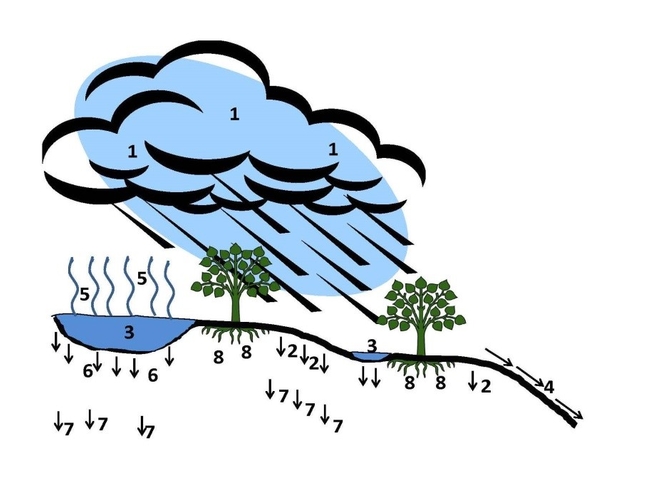All the media are full of stories about the impending El Nino effects and possible flooding rains in California. As I write this, it is the day before our first significant storm (Jan. 4) with a 100% chance of rain throughout Ventura county for tomorrow. Still long range forecasts for Jan and Feb show near normal or less than normal rainfall possibilities for the Avocado growing areas of California. The “real rain”, they say, will come in March. Although nobody can accurately predict the occurrence of rain, we are certainly due for an increased rain year based on statistical models and estimates of the El Nino effect by NOAA, JPL and NASA. If heavy rains are in the near future, nurserymen and growers will need to take measures to protect their operations from the many and disastrous effects of downpours. Physical displacement of soil as erosion and loss of soil are common during heavy rains. While runoff water should not leave agricultural properties, it has to move somewhere when rains come, so ditches should be cleared of weeds and other obstructions to permit efficient flow of water. Most operations will have already done this by now. So what can be expected when the rains come and after they leave? It will likely be a banner year for diseases both biotic and abiotic.
Many pathogens are splash inoculated from plant to plant or soil to plant, so it is imperative to prevent the development of flooded or puddled ground near growing areas. Now or between storms would be a great time to lay down additional gravel under container beds or other outside nursery areas. Keeping containers off soil, either with a gravel or fiber mat and gravel system is imperative when trying to control Phytophthora in nurseries. Compacted walkways and beds may become saturated this winter and create ideal sporulation conditions for Oomycetes or water molds which may then move in water flows to new areas of the nursery causing infections where never seen before. Consider boardwalks or additional gravel in known low spots and walkways so that workers don't move infested mud from one part of a nursery to another. For citrus and avocado growers it is vital to give water a place to go on flat or low lying areas. When we get the expected deluges, trees can suffocate from extended soil saturation and defoliate rapidly due to anoxic conditions.
For Phytophthora sensitive crops, it may be wise to increase the calcium by adding additional gypsum now to reduce sporulation and potential spread of disease. It is also wise to use preventative fungicides such as mefenoxam, and phosphorous acid to increase plant readiness for Phytophthora increases following wet weather.
This is also a great time for woody plant growers to prune any diseased or dead materials from plants ahead of winter rains because many Ascomycete canker fungi that cause disease in woody plants will have inoculum in dead twigs. This has been a banner year for Botryosphaeira fungi which have caused canker diseases in citrus, avocado and ornamentals at record levels due to drought stress. When rain comes, spores are splashed to new plants and can cause new infections. Since this is an El Nino year, it is warm, and warm rains are best for disease promotion. Remove inoculum now, cull and remove weak, diseased or dead plants ahead of the rains to cut down on disease spread. Even though it may be inappropriate to plant some crops now, it is always a good time to remove weak trees, plow diseased row crops and chip up the waste to be used as mulch.
With rains often come strong winds. Greenhouse and tunnel growers should consider the effects of wind this winter on their operations and possible crop loss from this damage. Tunnel houses used in berry and other production are at risk but other greenhouse materials such as polycarbonate sheeting can be detached by wind. Now is a great time to inspect and repair these structures or apply new sheeting as necessary. Wind can also move woody plants to rub against each other, causing injury to the main stem or fruit if tightly spaced. Trees that are blown over due to high winds can be damaged and devalued. Spend time now inspecting trellis systems and staking of woody plants to minimize damage that may be coming.
Outdoor nurseries that have planting media storage piles should start now to downsize these piles or provide new tarps in advance of wet weather. Greenhouse operations with media stored outside should ensure that bales are properly covered with new tarps to prevent saturation of the media. Media bales should be stored off the ground on raised pallets to avoid contamination with soil or mud flows.
The challenge of a wet and potentially stormy winter is to envision what excess water can do in your operation and then try to prepare. Flooding conditions create a time of potential pathogen movement and the best protection for plants is to keep them elevated above the mud and keep workers from spreading it with the movement of machinery or foot traffic. It is also useful to imagine invasion of soil from adjacent land owners who may have diseases or weeds not on your own property. Money spent now on infrastructure will prevent disease loss later this spring or summer.
